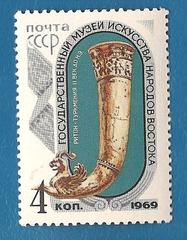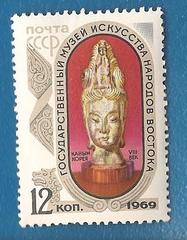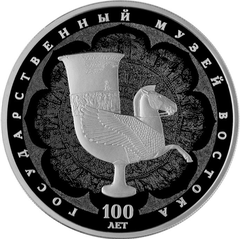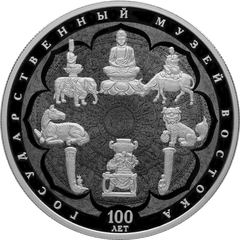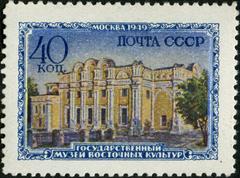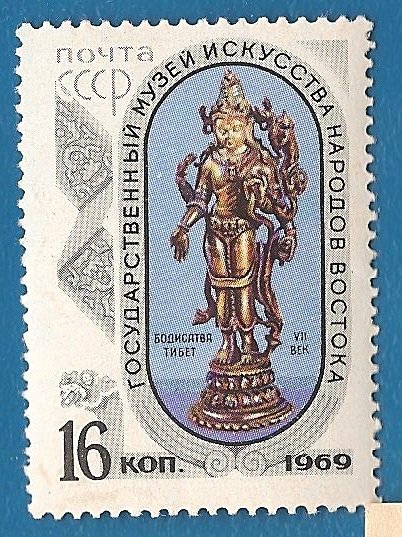
State Museum of Oriental Art, Moscow: Visiting Hours, Tickets, and Guide to Historical Sites
Date: 14/06/2025
Introduction
The State Museum of Oriental Art in Moscow is a renowned cultural institution devoted to the preservation and exhibition of the artistic heritage of Asia, the Middle East, the Caucasus, and Siberia. Established in 1918, it is one of Europe’s largest repositories of Oriental art, with over 150,000 artifacts spanning ancient Chinese ceramics, Japanese ukiyo-e prints, Persian miniatures, Indian bronzes, and Tibetan thangkas. Its main site—the neoclassical Lunin Mansion—offers a unique architectural backdrop, while the modern Pavilion No. 13 at VDNH reflects Soviet-era grandeur. The museum is committed to academic research, cultural diplomacy, and public education, offering guided tours, workshops, lectures, and family events. With central locations accessible by metro, inclusive facilities, and proximity to landmarks like the Kremlin and Red Square, the museum is an essential stop for anyone interested in the diverse cultures of the East (State Museum of Oriental Art Official Site; Russia Beyond; Moscow Museums).
Contents
- History of the State Museum of Oriental Art
- Visitor Information
- Lunins’ House and Pavilion No. 13 at VDNH
- Permanent and Temporary Exhibitions
- Educational Programs and Events
- Nearby Attractions
- Frequently Asked Questions (FAQ)
- Summary and Visitor Tips
- Additional Resources
History of the State Museum of Oriental Art
Foundation and Early Development
Founded in 1918 in the aftermath of the Russian Revolution, the State Museum of Oriental Art was created to celebrate and study the diverse cultures within the former Soviet Union and beyond (State Museum of Oriental Art Official Site). The museum’s original collection came from the nationalized holdings of collectors such as Pyotr Shchukin and Sergei Yevreinov, and it quickly established itself as a leading research and exhibition center for Oriental art.
Expansion and Research
Throughout the 20th century, the collection expanded through archaeological expeditions, diplomatic exchanges, and donations. Today, it includes over 150,000 items from East Asia, Southeast Asia, Central Asia, the Caucasus, the Middle East, and North Africa (Russia Beyond). The museum’s research activities are supported by an extensive library and regular academic conferences (Moscow Museums).
Cultural Significance
During the Soviet era, the museum promoted unity among the USSR’s diverse peoples through exhibitions and educational outreach. Today, it continues as a center for international cultural exchange, hosting exhibitions of contemporary Oriental art and safeguarding cultural heritage from conflict regions (The Art Newspaper Russia).
Architectural Heritage
The Lunin Mansion, dating from the 1820s, is a neoclassical masterpiece designed by Domenico Gilardi. Its restored interiors highlight Asian art in a historically significant setting (Moscow Info). The museum’s facilities include temporary galleries, a concert hall, educational spaces, and multilingual signage.
Modernization and Milestones
For its centenary in 2018, the museum introduced digital initiatives such as virtual tours and an online catalog (Official Virtual Tour). Expanded educational programming includes lectures, workshops, and family activities.
Visitor Information
Location and Access
- Main Building (Lunin Mansion): 12A Nikitsky Boulevard, near Arbatskaya and Barrikadnaya metro stations (Google Maps)
- Pavilion No. 13 at VDNH: 119 Prospekt Mira, accessible via VDNH metro station
Visiting Hours
- Lunin Mansion: Tuesday–Sunday, 11:00–20:00; closed Mondays
- Pavilion No. 13: Wednesday–Sunday, 10:00–18:00; closed Mondays and Tuesdays
- Check the official website for up-to-date schedules and special events
Ticket Information
- Lunin Mansion: 300–500 RUB general admission; discounts for students, seniors, and children; children under 16 free (some exhibitions may have separate tickets)
- Pavilion No. 13: 250 RUB general admission; concessions available
- Tickets available online and at the entrance
Accessibility
Both venues offer wheelchair access, ramps, elevators, and accessible restrooms. Audio guides and printed materials are available in multiple languages.
Facilities
- Café, gift shop, cloakroom, free Wi-Fi, mobile app for self-guided tours
Photography Policy
Non-flash photography is allowed in permanent exhibitions; restrictions may apply in temporary exhibitions.
Lunins’ House and Pavilion No. 13 at VDNH
Lunins’ House: Neoclassical Core
- Significance: Early 19th-century neoclassical mansion designed by Domenico Gilardi
- Features: Ornate ceilings, stucco moldings, period fireplaces, restored interiors
- Hours: Tuesday–Sunday, 11:00–19:00; closed Mondays
- Tickets: 300 RUB general; discounts available; online or onsite purchase
- Accessibility: Ramps, elevators, audio guides (orientmuseum.ru)
Pavilion No. 13 at VDNH: Soviet Heritage
- History: Built in 1939, restored 2017–2018; combines Armenian and Soviet motifs
- Exhibitions: Hosts major rotating exhibitions, including the 2024–2025 Chinese artifacts show (globaltimes.cn)
- Facilities: Modern amenities, barrier-free access
- Hours: Wednesday–Sunday, 10:00–18:00; closed Mondays and Tuesdays
- Tickets: 250 RUB general; discounts available (orientmuseum.ru/filial)
Permanent and Temporary Exhibitions
Permanent Collections
The museum’s holdings span the cultures of Asia, the Caucasus, and Siberia, with highlights including:
- Chinese Art: Ceramics, jade, calligraphy, Buddhist sculpture
- Japanese Art: Ukiyo-e prints, samurai armor, lacquerware, netsuke
- Korean, Indian, Iranian, Central Asian, and Siberian Art: Porcelain, textiles, jewelry, folk and applied arts, archaeological finds
- Nicholas and Svyatoslav Roerich Collection: Over 800 works by the Roerich family, focusing on the Himalayas and Central Asia
- Buddhist Art: Sculptures, ritual objects, thangkas, manuscripts
- Folk and Applied Arts: Carpets, woodcarving, metalwork, textiles, shamanic artifacts (Wikipedia; MyGuideMoscow; Russia-IC)
Temporary and Special Exhibitions
- Rotating exhibitions focus on themes, artists, or regions, including loans from international collections
- Contemporary Oriental art exhibitions foster dialogue between tradition and modernity
- Cultural events include dance, music, art workshops, and tea ceremonies (Russia-IC; Orientmuseum.ru)
Educational Programs and Events
For Children and Families
- Interactive workshops, quests, and creative sessions for ages 6–12 (“Oriental Kaleidoscope”)
- Family days with storytelling, puppet theater, and hands-on crafts (Children’s Programs)
For Adults
- Public lectures, seminars, and masterclasses on topics like Islamic art, Japanese ceramics, and Central Asian embroidery (Events Calendar)
- Weekend workshops (painting, calligraphy, origami, music) (Workshops)
School and University Partnerships
- Tailored tours and workshops for students; collaborations with leading universities; internships and research opportunities (Annual Report)
Digital Initiatives
- Virtual tours, high-resolution image galleries, online lectures, webinars, and an interactive platform for children (Virtual Museum)
Special Events
- Annual festivals such as “Oriental New Year,” featuring performances, craft fairs, and culinary demonstrations (Festival Announcements)
Nearby Attractions
While visiting, consider exploring:
- Red Square and Kremlin: Moscow’s historic heart
- Tretyakov Gallery: Iconic Russian art
- Gorky Park: Urban park and leisure space
- Arbat Street: Historic pedestrian street
- VDNH Exhibition Grounds: Pavilions, fountains, and parks
Frequently Asked Questions (FAQ)
Q: What are the museum’s visiting hours?
A: Lunin Mansion: Tuesday–Sunday, 11:00–20:00; Pavilion No. 13: Wednesday–Sunday, 10:00–18:00. Closed Mondays (and Tuesdays for Pavilion No. 13).
Q: How do I buy tickets?
A: At the museum entrance or online via the official website.
Q: Is the museum accessible for people with disabilities?
A: Yes, both buildings offer ramps, elevators, and accessible restrooms.
Q: Are guided tours available in English?
A: Yes, by prior arrangement.
Q: Can I take photographs?
A: Non-flash photography is allowed in permanent exhibitions; check signage for temporary exhibition policies.
Summary and Visitor Tips
The State Museum of Oriental Art is a vibrant gateway to the artistic traditions and histories of Asia, the Middle East, and neighboring regions. Its permanent collections, engaging temporary exhibitions, and architectural settings offer a comprehensive cultural experience. Visitor amenities—multilingual tours, accessible facilities, workshops, and digital resources—ensure inclusivity and enrichment for all ages. Proximity to Moscow’s top landmarks makes it an ideal addition to any cultural itinerary.
For the latest updates on hours, tickets, and events, consult the museum’s official website. Enhance your visit by downloading the Audiala app for audio guides and insider tips, and follow the museum on social media for real-time announcements.
Additional Resources and Links
- State Museum of Oriental Art Official Site
- Lunin Mansion Information
- Pavilion No. 13 at VDNH
- Global Times Chinese Art Exhibitions
- Russia Beyond – Moscow Museum of Oriental Art
- Moscow Museums Overview
- The Art Newspaper Russia – Oriental Art Museum
- MyGuideMoscow Museum Guide
- Russia-IC Museum Profile
- Wikipedia – State Museum of Oriental Art
- Museum Shop
- Children’s Programs
- Volunteer Program
- Virtual Tour

